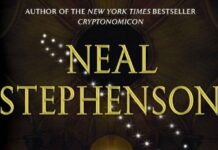
Ebook Info
- Published: 2012
- Number of pages: 464 pages
- Format: Epub
- File Size: 1.26 MB
- Authors: Neal Stephenson
Description
This riveting second installment in Stephenson and company’s epic tale focuses on the aftermath of the world-shattering Mongolian invasion of 1241 and the difficult paths undertaken by its most resilient survivors.
The Shield Brethren, an order of warrior monks, search for a way to overthrow the horde, even as the invaders take its members hostage. Forced to fight in the Mongols’ Circus of Swords, Haakon must prove his mettle or lose his life in the ring. His bravery may impress the enemy, but freedom remains a distant dream.
Father Rodrigo receives a prophecy from God and believes it’s his mission to deliver the message to Rome. Though a peaceful man, he resigns himself to take up arms in the name of his Lord. Joining his fight to save Christendom are the hunter Ferenc, orphan Ocyrhoe, healer Raphael, and alchemist Yasper, each searching for his place in history.
Deftly blending fact and fantasy, The Mongoliad: Book Two captures the indomitable will to survive against immense odds.
User’s Reviews
Review “Suggestions of revelations to come combine with expertly crafted fight sequences and immensely enjoyable characters to hold the reader’s interest.” -Publishers Weekly” I loved this book. The action was some of the best I’ve read in a while. Each fight is important to the story. The battles range from one-on-one to ten-on-sixty. Each one is the right kind of detailed and wonderfully inventive. The characters are well drawn and multi-faceted… The plot pulled me to the next page relentlessly. I was thrilled when it was time for a battle, and I was thrilled when it was time for character development. I spent the entire time excited to see what this book had in store next. I am now excited to see what the next book has in store. I cannot recommend this one enough. Five Lovable Mongol Hordes out of Five.”-Ben Rhodes, Fanboy Comics “Fact and fiction are seamlessly blended to create a detailed vision of 13th Century Asia and Europe, and the fear of the overwhelming Mongol horde is palpable. The violence is detailed but not gratuitous, and the fact that likeable characters aren’t safe proves the authors are not afraid to make sacrifices in order to provide a wonderful story.”-Geek Planet Online “[a] sprawling, character-rich, action-packed epic that’s part history, part alternate history, part fantasy, part martial-arts saga…Jumping from place to place and character to character, the book has a potentially huge audience, not just fans of the individual contributors and readers of Book One but also the much larger fan bases for martial-arts epics, alternate history, and historical fantasy.”-Booklist
Reviews from Amazon users, collected at the time the book is getting published on UniedVRG. It can be related to shiping or paper quality instead of the book content:
⭐ This saga has an intriguing premise, a stellar stable of authors, a fascinating mix of historical detail and plausible speculation, and a veritable Gordian knot of plot lines. And with all that it can’t seem to rise to greatness. Perhaps that is because this volume is just a giant chapter in the greater whole, without a proper beginning, climax, or ending. The writing is good, the characters and settings are interesting, but it just doesn’t gel into a comfortably cohesive story.
⭐ As if the first book hadn’t introduced enough, this book chooses to make it even more complicated by introducing a plot regarding the election of the Pope, which actually was a rather notorious event that happened to coincide with the Mongol Invasion. In this book it is only tangentially related by two survivors of the Battle of Mohi, the base event setting the entire story in motion, ending up in Rome and one being Father Rodrigo, a priest with connections to the OMVI or Shield Brethren managing to get into the papal conclave and give us semi-relevant eyes into the whole situation. Meanwhile, the other survivor is Ferenc a Magyar hunter who only knows his unique regional dialect and is entirely unable to communicate with anyone else in Rome, except a young Binder named Ocyroe who can communicate using Rankos Kalba, a form of sign language as fictional as the Binders themselves. We still aren’t given much information on these Binders, they are an all female order of messengers with a secret language, but beyond that we know nothing. A large portion of the book is dedicated to these events, but nothing is said of what this has to do with anything else beyond a shared starting point and time.Meanwhile, in Poland, the story of the circus of swords is elaborated upon following Andreas and Rutger against the Knights of Livonia and Ongwe Khan and their alliance with Kim Alcheon and Zugokaitso no Yama. Farther East, the main heroes get very little coverage as they follow the Silk Road to Mongolia in an attempt to assassinate Ogedei Khan, a plot prolonged primarily by simply being ignored for most of the book. The most consistent story is that of Gansukh and Lian who travel beyond the walls of Karakorum to the borderlands of China.The story, or rather stories are rather good, but the pace at which the authors switch between them can be annoying, you get started enjoying one story and it switches to something else. In my attempt to write a fanfiction for Kindle Worlds I was very interested in following the story of Hakkon, but after a chapter or two he is mostly forgotten- not dead though, the last mention is that Ongwe Khan delivered him to his father and he is now on the road with the Khagan and Gansukh and Lian, but with the focus in that area shifted off of him, he becomes invisible background. I started reading this thinking I was going to mainly get a story of the fighting Shield Brethren, but this ended up being more about the political intrigue in the Vatican and the romance of Gansukh and Lian and woefully little was said about the people I wanted to read about. Also, the back cover blurb once again has a false sell, suggesting more of a connection between the people in Rome and the travelers on the Silk Road than is actually demonstrated. I can only hope the third installment brings everything together better than this book did.
⭐ If you are considering part two of the Mongoliad, then you have certainly read part one. If not, I would do so, before picking up the succeeding volumes. I purchased all three Mongoliad novels, so feel compelled to finish them. Had I only purchased the first one, I likely would not have purchased parts two and three. These are not awful novels, but they are utterly mediocre, with little to recommend them.Part two continues the story threads introduced in part one while introducing a new one centered on Rome and a contentious papal election. The Teutonic Knights continue their quest and the court of the Mongol Khan continues with little change. As you would expect in any part two of a trilogy, little is resolved.I feel compelled to comment upon one scene from the Mongol court thread. In it, a Mongol warrior reveals himself to be quite a sensitive and patient lover. Really? In a collaboration involving six or seven authors, I can only guess that this segment was penned by a Harlequin romance specialist.
⭐ This is the continuation of the story of the Shield-Brethren (alternately, the Knights of the Virgin, or the Order, or the Ordo Militium Vindictus Intactae, or probably a couple other things I forgot) as they press onward with their mad quest to assassinate the Khan and turn back the Mongol horde currently invading Christendom. Part Two continues the storyline of Feronantus and his band of assassins pushing deep into the East and the storyline of Gansukh the faithful warrior to the drunken Ogedei Khan, touches briefly on the story of Haakon and the other captive champions, and introduces two new stories: those of yet another company of Shield-Brethren and their nemeses, the Livonian Knights, and of the imprisoned College of Cardinals in Rome, struggling to choose a new Pope, and the mysterious stranger Father Rodrigo who arrives in their midst.Does that sound like a lot of storylines? It is. And since some of these plots have subplots within them, we’re getting very dangerously close to having too much going on here. As I pressed onward into the book, I was reminded of the feeling I would get reading Wheel of Time that there was more going on than I could keep track of. This was especially the case with the Rome plotlines; we’re introduced to Cardinal after Cardinal, each with his own agenda, but even by the end of the book, I still wasn’t sure how that story arc was relevant to the Order and their mission. Was it a detail I missed from Book One? Maybe so, but if it was, I think it ought to have been made clearer. This book also suffers somewhat from middle-volume-syndrome. There’s not a lot of dramatic stuff that happens, and the spectacular fighting sections (like the two-chapter duel between Haakon and Zug or the ambush of the Mongolian cavalry by Feronantus and his men) are rather less well-represented in this second volume. I was also disappointed to encounter an unexpected (and pretty well unexplained) sex scene. The first volume was better off without that.One hopes that Book Three will tie all this nicely together and make up for the shortcomings here, since Book One was so enjoyable and so promising.
⭐ The Mongoliad is written by my favorite authors and I looked forward to reading the series. In most regards it does not disappoint, because as usual with Stephenson, it is bursting with strong characterizations braided with historic detail, in this case the spread of the Mongol empire after the death of Ghengis Khan, combined with thorough descriptions of the last of the Crusades and how the two epics of history collided. I am stunned with the accuracy of the historic detail and how, for example, one line of history is expanded into a tale that brings the history and people alive, a technique repeated throughout. The story is peppered with famous stories in history such as of Francis of Assisi, Ogedei Khan, the selection of the Pope, and many others. There are too many such stories to be adequately covered in a short review.Who would have thought I would feel sympathy for Ogedei Khan even as his empire begins to crumble, or identify with the struggles of faith in some of the main Christians in the Crusades while chopping each other up?So why only three stars? Because for me it was over the top with descriptions of battles, sword techniques, blood, and guts. Clearly the authors enjoy the ‘art’ of medieval weaponry and how they are used to chop, dismember and annihilate each other, but it was too much for me. I do not think such excessive detail in every battle scene improved the overall story. Aficionados of medieval battles will love it, and perhaps even learn some history.I have not decided if I will read Book Three, perhaps just to see the ending but not for more battle details.
⭐ I liked the Mongoliad Book One, despite the prevalence of myriad povs and plotlines. It gives a composite view of the era, the peoples, and the turmoil both inner and outer. A bit complicated, but very enjoyable.Book Two, however, takes that complication to an extreme, introducing more and more and more povs and plotlines. Visiting previous ones on occasion, time and place get confused, future scenes predate past scenes, we see an important happening take place from a bystander’s eyes, we learn that a previous “main character” is dead, things circle and circle faster and faster, things fall apart, the center cannot hold.I got lost about halfway through the book. I read the first book straight through. I kept putting the second down. It didn’t keep my interest. Every chapter was a new beginning. It didn’t flow. Reading became a chore.It’s less of a novel and more of a collection of interrelated short stories. Perhaps a complicated short story novel? A story arc?It’s still very interesting, just hard slogging. I fully plan to pick it up again some day.
⭐ This is a 4 book series and a collaborative effort lead by Neal Stephenson. The writing is tight and even though there are different authors the story flows properly and they have observed each others styles. Books One and Two are the best. Book Three could have been more satisfying and felt kind of choppy as they explored a particular part of the story line. I though Book Four to be the weakest of the series, but they were trying to tie up a lot of loose ends and that is the risk for such an undertaking. Overall a good read. Maybe stop after Book Two and wonder what happened.
⭐ I don’t know how a group of authors can so seamlessly blend styles and stories together into such a great work. Book two continues the adventures of characters in book one while folding in new and exciting characters. The palace intrigue on in the Mongol empire and the struggles for power within Rome make this a truly epic tale.
⭐ Why I picked it up: I became aware of the Mongoliad through the Sword and Laser YouTube show two years ago. I usually love historical fiction and this was dealing with an area of history that intrigues me as well as with aspects that I haven’t explored before (particularly anything to do with the Mongols). The same Amazon Kindle Daily Deal that allowed me to pick up Book One for cheaper, I also bought Book Two and Book Three at the same time. But I chose to read Book Two right after finishing Book One because the ending of Book One was so abrupt. I had a feeling that if I didn’t immediately begin reading Book Two, I would have forgotten characters and where the last book left off. I was extremely accurate.What’s it about, very quickly? Book Two picks up directly where Book One left off. It adds a new thread or storyline, this one about the choosing of a new Pope and the first ‘conclave’ of cardinals. The Shield Brethren are still on their mission to the East, while the rest of their number try to navigate the gladiatorial battles of the Mongol circus, and a Mongol warrior learns more diplomacy. Basically, a lot of detailed storylines going on simultaneously.My initial thoughts: Oh my gosh, so many characters! I was pretty confident after Book One that I had a firm grasp of the storylines and the characters in them, but with the addition of a new thread with a bunch of new characters, it became difficult to follow at points. And I cannot express enough how grateful I am that I was able to immediately read Book Two after finishing Book One. There was no recap of what had happened previously.My conclusion: I think this book suffered a little by adding another thread of the Rome politics. With all the subplots going on in that single thread, it almost overshadowed the rest of the threads. And while those parts were definitely interesting, it made too great a gap between each thread’s chapters. Unless I had enough time to read big chunks at a single time, it was difficult to remember where a certain group of characters were and what they were doing by the time I got to their chapter. I did really appreciate how the book showed all the different things that happen simultaneously in history, despite some liberties taken with that history. I will be moving on Book Three as soon as I can to finish this odyssey.
⭐ I bought the first novel in this series in an airport by chance, just because Stephenson’s name was on it, and was instantly hooked. (Mongol hordes, knights, great female characters–what’s not to like?). The second book moves the story along as it needs to, but it’s not quite as strong as the first. The writing is a bit uneven and you do get whipsawed around between the different narratives. I’ve already pre-ordered the third, though, and plan to reread them all in order when it arrives.Anyone suffering from withdrawal as they wait for the last installment in this trilogy might enjoy Elizabeth Bear’s latest book, “Range of Ghosts,” which is set in a kind of alternate Mongolia after the death of the Great Khan. It’s riveting! (Be warned, however, that it is also the first in a series, and you may be set off on a kind of recursive Mongol withdrawal cycle when it, too, ends abruptly–but still, great book!)
Keywords
Free Download The Mongoliad (The Mongoliad Cycle Book 2) in Epub format
The Mongoliad (The Mongoliad Cycle Book 2) Epub Free Download
Download The Mongoliad (The Mongoliad Cycle Book 2) 2012 Epub Free
The Mongoliad (The Mongoliad Cycle Book 2) 2012 Epub Free Download
Download The Mongoliad (The Mongoliad Cycle Book 2) Epub
Free Download Ebook The Mongoliad (The Mongoliad Cycle Book 2)




